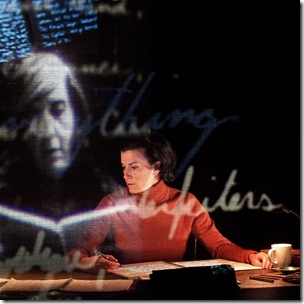Sontag: Reborn: A History Lesson in Multimedia at ArtsEmerson’s Paramount Theatre
Moe Angelos as Susan Sontag. Photo James Gibbs
Sontag: Reborn, the second production the Builders Association has brought to ArtsEmerson this season is another intermedial piece. Like its predecessor, Sontag: Reborn relies heavily on video to tell its story. Unlike its predecessor, House Divided, a drama of many characters, complex setting, and numerous incidents that revolve around the Great Depression and the Great Recession, Sontag: Reborn is a dialogue with one character.
Joshua Higgason’s simple setting, consisting of a wide rectangular desk covered with various and changing props, a scrim in front of it and a screen behind with a camera above; Laura Mroczkowski’s varied lighting; Dan Dobson’s sound design; and Austin Switser’s brilliant video work bring vivid life to a piece that had the potential to bore.
The play, taken from Susan Sontag’s journal which covers her life from age 15 to 31, was adapted by Moe Angelos, who also enacts the character. In it, we see a precocious adolescent become a professional intellectual reminiscent of French philosophers of the middle and late twentieth century. She shared with them an intense interest in a broad range of topics. Her extensive ambitions as well as her acuity brought her into contact with the top ranking minds in the world of the humanities, high culture, and academia.
Upon graduating a public high school in 1948 at age 15, she entered Berkeley, succumbed to what she called her “lesbian tendencies,” and after a semester transferred to the University of Chicago attracted by its interdisciplinary curriculum and high-powered faculty, several of whom she cultivated as friends. At Chicago, she branched out into heterosexual sex for a period, marrying Philip Reif, her sociology instructor, shortly after meeting him. Their unhappy marriage lasted eight years and produced their son David. Sontag received her BA at 18 and the couple moved to Cambridge, Massachusetts where Sontag did an MA in philosophy at Harvard and began her PhD studies in metaphysics.
When she received a fellowship to Oxford, she left husband and son behind, although the play presents her as a loving mother during his early childhood. In 1957, she went to Paris where she spent two very influential years, travelled to Germany and returned to the US to settle in New York and strive for success and fame. Her long-term lovers, such as playwright Irene Fornes, were high culture celebrities who matched Sontag’s vision of herself. Sontag was unabashedly egocentric, viewing the writer as a person “in love with himself [who] makes his writing out of that love.”Angelos captures that characteristic perfectly.
Sontag relates her story mostly sitting at her desk, cluttered with the books and papers that fed her mind. Later, a typewriter is added that symbolizes Sontag the budding author and the era in which she first wrote and captured as a critic. From time to time the camera focuses on the workspace, giving the audience a glimpse of Sontag’s world from her perspective. While the show seems active Moe Angelos, actually moves very little. The sense of onstage movement comes from the upstage screen where the constantly running video gives a frenetic and literally fuzzy picture of her experiences and the culture that she imbibed and contributed to in her literary works.
Stage left, a prerecorded video presents the older and larger-than-life Sontag, recognizable by her usual cigarette in hand and trademark white stripe running through her dark hair. The age difference between the two is emphasized by the rough black and white images which recall the nouvelle vague films of the 1950s. Sontag the elder observes her younger self composedly, making ironic comments on occasion. In contrast to her passionate and occasionally self- doubting younger persona, the older Sontag comes off as cold. Moe Angelos’s performance of the two Sontags is a feat. Marion Weems is to be congratulated for her direction of the play.
Sontag: Reborn
Created by the Builders Association
Adapted and performed by Moe Angelos
Directed by Marianne Weems
Video design by Austin Switser
Sound design by Dan Dobson
Lighting design by Laura Mroczkowski
Set design by Joshua Higgason
